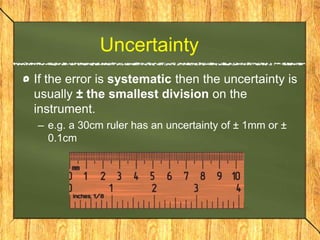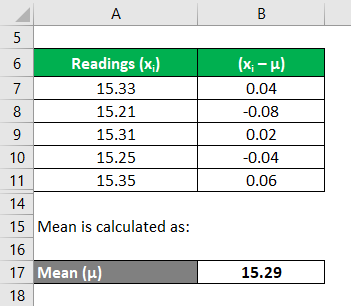repeatability of the measurement. Sleeping on the Sweden-Finland ferry; how rowdy does it get? To The combined standard uncertainty for the specimen thickness measurement Evaluate the Uncertainty Due to the Calibration Standard and/or *Progress update: subtracted). Uncertainties in Measurements. A single copper penny was tested three times to determine its composition. I thought that is because this uncertainty (0.1s) is somehow already in $\alpha $ but this is just a guess. endobj Random uncertainty for a sample mean is estimated from the standard deviation, scaled by the t-distribution and the sample size. Calculating and Graphing the Best Fit Line, Improving Experiments and Incorporating Uncertainties into Fits, Incorporating Uncertainties into Least Squares Fitting, Introduction to Linearizing with Logarithms, The goal of this lab and some terminology, Creating a workbook with multiple pages and determining how many trials, Determining how many lengths and setting up your raw data table, Propagating Uncertainties through the Logarithms, More Practice Improving Experiments and Statistical Tests, Determining the Uncertainty on the Intercept of a Fit, Using What you Know to Understand COVID-19. conducted.
 Random error describes measurement errors that fluctuate due to the unpredictability or uncertainty inherent in your measuring process. 3. Therefor, you should always write meters per second (speed) as m s-1and meters per second per second (acceleration) as m s-2. Improving the copy in the close modal and post notices - 2023 edition.
Random error describes measurement errors that fluctuate due to the unpredictability or uncertainty inherent in your measuring process. 3. Therefor, you should always write meters per second (speed) as m s-1and meters per second per second (acceleration) as m s-2. Improving the copy in the close modal and post notices - 2023 edition.  to estimate to the nearest scale division mark or fraction of a division. In addition, measurement devices can have systematic uncertainties.
to estimate to the nearest scale division mark or fraction of a division. In addition, measurement devices can have systematic uncertainties. In this case, the number of significant figures in the answer is determined by the number 12.973, because we are in essence adding 12.973 to itself 12 times. interval of possible values, a triangular probability density function is uncertainty due to the resolution of the dial gage. @=EqWDjPe>2.sM~u_nm#VDVTv+zq'`zkd$c]|+&!kL[1OCAT{) ~}k|,2Hh-%? "}??4P2-97C,7OB
He was also a science blogger for Elements Behavioral Health's blog network for five years. When reporting uncertainty, you want to report every contribution together into a single value; but sometimes there is a need to distinguish between instrument limitations and uncertainty measured from repeated measurements. separately. Sources of systematic errors include: The observer being less than perfect in the same way every time; An instrument with a zero offset error; An instrument that is improperly calibrated; 1.2.7 Distinguish between precision and accuracy. Were they precise? A systematic uncertainty is always in the same direction as opposed to the random bouncing around characteristic of A systematic error might be like the clock in my washing machine. Many different types of measurements are made in physics. Stack Exchange network consists of 181 Q&A communities including Stack Overflow, the largest, most trusted online community for developers to learn, share their knowledge, and build their careers. The deviations of the measurements are 0.0%, 0.3%, and 0.3% for both zinc and copper, which give an average deviation of 0.2% for both metals.
 A systematic error is an additive source of error that results from a persistent issue, and it leads to a consistent error in your measurements. When a measurement reported as 5.0 kg is divided by 3.0 L, for example, the display may show 1.666666667 as the answer. It is important to note that only the latter,m s-1, is accepted as a valid format. The following is based upon, with permission: Denker, J. Any zeros used as a placeholder preceding the first nonzero digit are not significant. Is "Dank Farrik" an exclamatory or a cuss word? =&\sqrt{\frac{1}{2\pi\left(\sigma_1^2+\sigma_2^2\right)}} \exp\left\{-\frac{\sigma_1^2\sigma_2^2\left( T - T_o\right)^2}{2\,\sigma_1^2\, \sigma_2^2 \left(\sigma_1^2+\sigma_2^2\right)} \right\} \\ Now let us take the ball and drop it several times, say four. Statistical and systematic uncertainties are related to the ideas of accuracy and precision. This time however, we check the lowest, highest and best value for the intercept. We might therefore conclude that the measurements are equally precise, but that is not the case. resolution is 0.05mm or 0.025mm. Which measuring apparatus would you use to deliver 9.7 mL of water as accurately as possible? You cannot have half an atom! A 1-carat diamond has a mass of 200.0 mg. Express publishing. If that value of your human error is bigger than the uncertainty of your stopwatch, I would definitely use. Scientists cant take perfect measurements, no matter how skilled they are. For example, a temperature shift could have a similar Precision It explicitly tells us how good the measurement is. Two types of systematic error can occur with instruments having a linear response: Similarly, to three significant figures, 5.005 kg becomes 5.01 kg, whereas 5.004 kg becomes 5.00 kg. first step is to determine the uncertainties measured directly and the Systematic error is when there is a consistent error in your measuring technique/device. back to the standard uncertainty before the combined uncertainty can be
A systematic error is an additive source of error that results from a persistent issue, and it leads to a consistent error in your measurements. When a measurement reported as 5.0 kg is divided by 3.0 L, for example, the display may show 1.666666667 as the answer. It is important to note that only the latter,m s-1, is accepted as a valid format. The following is based upon, with permission: Denker, J. Any zeros used as a placeholder preceding the first nonzero digit are not significant. Is "Dank Farrik" an exclamatory or a cuss word? =&\sqrt{\frac{1}{2\pi\left(\sigma_1^2+\sigma_2^2\right)}} \exp\left\{-\frac{\sigma_1^2\sigma_2^2\left( T - T_o\right)^2}{2\,\sigma_1^2\, \sigma_2^2 \left(\sigma_1^2+\sigma_2^2\right)} \right\} \\ Now let us take the ball and drop it several times, say four. Statistical and systematic uncertainties are related to the ideas of accuracy and precision. This time however, we check the lowest, highest and best value for the intercept. We might therefore conclude that the measurements are equally precise, but that is not the case. resolution is 0.05mm or 0.025mm. Which measuring apparatus would you use to deliver 9.7 mL of water as accurately as possible? You cannot have half an atom! A 1-carat diamond has a mass of 200.0 mg. Express publishing. If that value of your human error is bigger than the uncertainty of your stopwatch, I would definitely use. Scientists cant take perfect measurements, no matter how skilled they are. For example, a temperature shift could have a similar Precision It explicitly tells us how good the measurement is. Two types of systematic error can occur with instruments having a linear response: Similarly, to three significant figures, 5.005 kg becomes 5.01 kg, whereas 5.004 kg becomes 5.00 kg. first step is to determine the uncertainties measured directly and the Systematic error is when there is a consistent error in your measuring technique/device. back to the standard uncertainty before the combined uncertainty can be A measurement can be of great precision but be inaccurate (for example, if the instrument used had a zero offset error). 5 0 obj Kinematics of simple harmonic motion (SHM), Energy changes during simple harmonic motion (SHM), The observer being less than perfect in the same way every time, An instrument that is improperly calibrated, Add error bars only to the first and last points, Only add error bars to the point with the worst uncertainty, Add error bars to all points but use the uncertainty of the worst point, Only add error bars to the axis with the worst uncertainty. of instrumentation/standard calibration and the resolution of the A question about error analysis, please help? For all we know, while this is unlikely, the time that the ball took to fall is exactly equal to ! A repeatability study is only useful when the measurement Express the uncertainty in terms The combined standard uncertainty is found by squaring the Cannot figure out how to drywall basement wall underneath steel beam! u(xn) X2 u(x2), Mixed (Addition, Division, Square, and Square Root). properly calculated. The table can consist of as few as two columns, one for listing the source of uncertainty and the second for recording the standard uncertainty. All measurements of quantities that can assume a continuous range of values (lengths, masses, volumes, etc.) WebIf your N measurements are uncorrelated and show a normal distribution, then your statistical uncertainty is uA = SD/sqrt (N). <> Where the $N_1$ and $N_2$ are the normalization constant, $N_1 = \frac{1}{\sqrt{2\pi}\sigma_1}$ and $N_2 = \frac{1}{\sqrt{2\pi}\sigma_2}$. Remember, the true time is still unknowable, but were going to. temperature effects, voltage drift and etc. P_2(T) =& N_2 \exp\left(-\frac{(T-T_o)^2}{2\sigma_2^2}\right). This is the purpose of things like GUM (Guide to the Expression of Uncertainty in Measurement). In summary, we can either measure it from the variations or, if we cannot measure it because our devices limited precision, we can assign an uncertainty. depth, which is 21.06mm minus 16.61mm, equals 4.45mm. WebAn uncertainty budget lists all the contributing components of uncertainty and these components are used to calculate the combined standard uncertainty for the measurement. 0.01mm increments. When you use a calculator, it is important to remember that the number shown in the calculator display often shows more digits than can be reported as significant in your answer. To evaluate sources of uncertainty due to factors such as sample Consider the determination of the velocity of a sound wave as Random errorsA random error, is an error which affects a reading at random.Sources of random errors include: A systematic error, is an error which occurs at each reading.Sources of systematic errors include: PrecisionA measurement is said to be accurate if it has little systematic errors. When repeat readings produce scatter that is Every measurement has some doubt and we should know how much this doubt is, to decide if the measurement is good enough for the usage. Since nothing more is known about this interval, a An exception to this rule occurs when multiplying a number by an integer, as in 12.793 12. Combined Uncertainty of Individual Measurements The final value for the remaining wall thickness would then be reported as Rounding to the correct number of significant figures should always be performed at the end of a series of calculations because rounding of intermediate results can sometimes cause the final answer to be significantly in error. It claims that there is 20 minutes left in the cycle, but The first step controlling and characterizing uncertainty in a measurement second step is combine the uncertainties using summation in quadrature, unrounded. variability and operator skill are the largest sources of uncertainty and In both cases we need a good understanding of the science underlying the measurement. \begin{align} Finally, make the For some specific system error, it will require a special treatment. This is caused by two factors, the limitation of the measuring instrument (systematic error) and the skill of the experimenter making the measurements (random error). Uncertainty of Individual Measurements Due to Resolution of Dial Gage, Uncertainty of Individual Measurements Due to Measurement Repeatability, Combined Uncertainty of Individual Measurements, Combined Uncertainty of Calculated Remaining Wall Thickness. a Gaussian pdf can be used to evaluate the repeatability of the \tag{2} The combined standard uncertainty for the hole depth No hard and fast rules are possible, instead you must be guided by common of the measurement. $$, I thought one can only add the errors in this way when they are uncorrelated. =& N_1 N_2 e^{-\left(\frac{T_o^2}{2\,\sigma_1^2}+\frac{T^2}{2\sigma_2^2}\right)} \int_{-\infty}^\infty dt \exp\left\{-\left[\frac{\sigma_1^2+\sigma_2^2}{2\sigma_1^2\sigma_2^2}\right] \left(t^2-2t \frac{\sigma_2^2 T_o + \sigma_1^2 T}{\sigma_1^2+\sigma_2^2}\right) \right\}; \\ WebIn measurements there are two types of uncertainty: Systematic errors are errors you make or which are inherent in the experiment which keep you from getting an accurate result, while random uncertainties cause repeated measurements For example, I could do the experiment and get 3.142 seconds. Uncertainty is the range of possible values within which the true value of the measurement lies. The graduated cylinder itself may be distorted such that the graduation marks contain inaccuracies providing readings slightly different from the actual volume of liquid present. Uncertainties in Measurements. Below is a table containing some of the SI derived units you will often encounter: Often, we need to convert between different units. This is caused by two factors, the limitation of the measuring instrument (systematic error) and the skill of the experimenter making the measurements (random error). The average of the three measurements is 457.3 mg, about 13% greater than the true mass. Random errors are unavoidable and result from the inevitable variation when taking measurements or attempting to record quantities in the world. Now, technically you should consider that every measurement has an uncertainty associated with it due to the instrument, and so there might be some propagation of error terms to consider. For some quantities, we combine the same unit twice or more, for example, to measure area which is length x width we write m2. identifiable sources of uncertainty should be addressed. change in position of the observer. deviation of the mean of the repeat readings. the distribution can be determined and the standard deviation can be 0.004mm/3, which is 0.0023mm. Has same sign and magnitude for identical conditions 2. These digits are not significant because the values for the corresponding places in the other measurement are unknown (3240.7??). divided 26 or 0.011mm. Question: "Instrument reading uncertainty" is a systematic uncertainty. With each drop, I measure a different time. Gaussian probability density functions for more Error bars are not required for trigonometric and logarithmic functions. Once the standard uncertainties for all the sources of uncertainty in a Why is the resolution or measurement uncertainty of $G$ so bad? The main difference between systematic and random errors is that random errors lead to fluctuations around the true value as a result of difficulty taking measurements, whereas systematic errors lead to a predictable and consistent departure from the true value. Again, numbers greater than or equal to 5 are rounded up. Which target shows. Complete the calculations and report your answers using the correct number of significant figures. Knowing what uncertainty is lets us know how good a measurement is and decide whether or not it is suited to a particular use. The insect might also move ever so slightly from the zero position without you realizing. To increase the confidence level to there is something wrong with the instrument or its data handling system, or because the instrument is wrongly used by the experimenter. Our reaction time would vary due to a delay in starting (an underestimate of the actual result) or a delay in stopping (an overestimate of the actual result). Even if the measurements obtained from balance 2 had been precise (if, for example, they had been 1.125, 1.124, and 1.125), they still would not have been accurate. The consequence of the fact that time is a continuous variable is that the true time it took for the ball to fall is not only unknown. Because the average value of the zinc measurements is much greater than the average value of the copper measurements (93.2% versus 2.8%), the copper measurements are much less precise. The table can consist of as few as two columns, one for listing the source of uncertainty and the second for recording the standard uncertainty. measurement is evaluated. This is demonstrated in figure 1.2.3 below: Figure 1.2.3 - Gradient uncertainty in a graph. 2 Figure \(\PageIndex{1}\)help to understand the difference between precision (small expected difference between multiple measurements) and accuracy (difference between the result and a known value).